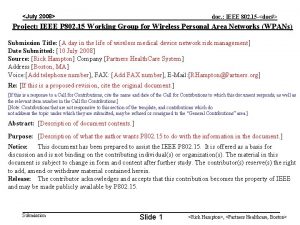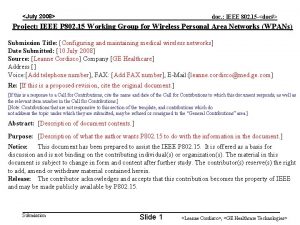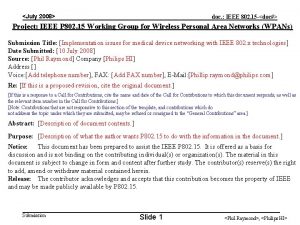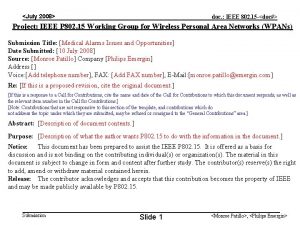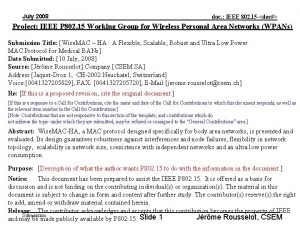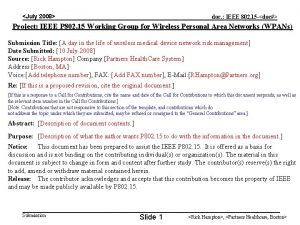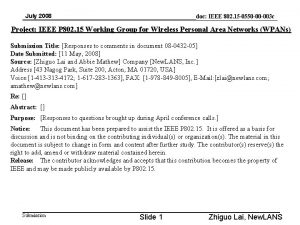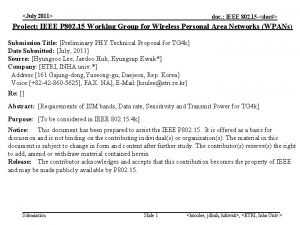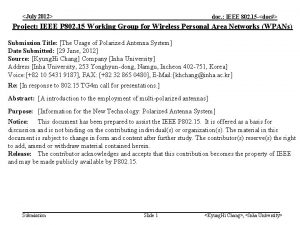July 2008 doc IEEE 802 15 doc Project











- Slides: 11

<July 2008> doc. : IEEE 802. 15 -<doc#> Project: IEEE P 802. 15 Working Group for Wireless Personal Area Networks (WPANs) Submission Title: [Medical Alarms Issues and Opportunities] Date Submitted: [10 July 2008] Source: [Monroe Patillo] Company [Philips Emergin] Address [] Voice: [Add telephone number], FAX: [Add FAX number], E-Mail: [monroe. patillo@emergin. com] Re: [If this is a proposed revision, cite the original document. ] [If this is a response to a Call for Contributions, cite the name and date of the Call for Contributions to which this document responds, as well as the relevant item number in the Call for Contributions. ] [Note: Contributions that are not responsive to this section of the template, and contributions which do not address the topic under which they are submitted, may be refused or consigned to the “General Contributions” area. ] Abstract: [Description of document contents. ] Purpose: [Description of what the author wants P 802. 15 to do with the information in the document. ] Notice: This document has been prepared to assist the IEEE P 802. 15. It is offered as a basis for discussion and is not binding on the contributing individual(s) or organization(s). The material in this document is subject to change in form and content after further study. The contributor(s) reserve(s) the right to add, amend or withdraw material contained herein. Release: The contributor acknowledges and accepts that this contribution becomes the property of IEEE and may be made publicly available by P 802. 15. Submission Slide 1 <Monroe Patillo>, <Philips Emergin>

doc. : IEEE 802. 15 -<doc#> Medical Alarms Issues and Opportunities Monroe Pattillo Philips Emergin, Product Manager monroe. pattillo@emergin. com Submission <Monroe Patillo>, <Philips Emergin>

doc. : IEEE 802. 15 -<doc#> Contents • • What is a Medical Alarm? What is the urgency? What is the gain? What gets in its way? Why prioritize it end to end? How should it be prioritized? How can it be assured? Recommendations Submission <Monroe Patillo>, <Philips Emergin>

doc. : IEEE 802. 15 -<doc#> What is a Medical Alarm? • Communication of a potentially patient life threatening event – heart failure • Short, typically text – CODE BLUE room 212 • Waveform snippets ~ 100 KB • Low occurrence by comparison Submission <Monroe Patillo>, <Philips Emergin>

doc. : IEEE 802. 15 -<doc#> What is the urgency? • Nurse call systems – assistance call, fall out of bed, request for a glass of water – message dependent, urgency ambiguous • Patient monitoring – life in the balance, CODE BLUE • Multiple, potentially uncontrollable, delay sources – – Physiological event determination End to end communication of the event (controllable) Human recognition of the severity of the event Response to the event (run to room, use equipment, do it) • Sub-second variability is tolerable • Seconds count, 10 is too long, 60 may equal dead Submission <Monroe Patillo>, <Philips Emergin>

doc. : IEEE 802. 15 -<doc#> What is the gain? • Improved response = lives saved • Reduced litigation by survivors Submission <Monroe Patillo>, <Philips Emergin>

doc. : IEEE 802. 15 -<doc#> What gets in its way? • Blocked or queued behind less important traffic – e-mail (blasts) – Video (live or stored streams) – Voice Vo. IP (PBX) – File transfers (PACS images) Submission <Monroe Patillo>, <Philips Emergin>

doc. : IEEE 802. 15 -<doc#> Why prioritize it end to end? • Only the source knows the urgency required to the destination • Priority shouldn’t vary in the middle of an end to end transit • Alarms transit multiple mediums – LAN, MAN, Wi-Fi, etc. • Every AP, switch & router along the way to urgently handle medical alarms Submission <Monroe Patillo>, <Philips Emergin>

doc. : IEEE 802. 15 -<doc#> How should it be prioritized? • • Submission Above Video/CBR (no avatars) Above Vo. IP (no TTS of alarms) Above file transfers (images) Above e-mail <Monroe Patillo>, <Philips Emergin>

doc. : IEEE 802. 15 -<doc#> How can it be assured? 1. Reserve (idle HOV lane) Seems like a waste of bandwidth 2. Prioritize (ambulance style) Seems ok, but they’re all taken 3. Indicate (line bully) Cascade and ordering side effects Submission <Monroe Patillo>, <Philips Emergin>

doc. : IEEE 802. 15 -<doc#> Recommendations • Priority definition currently bound to traffic source, not configurable, a change to priority standard requires hardware forklift replacement • Configurability of priority of source traffic – S/W, F/W update to sources • Rest of infrastructure works as-is • Basically push everything down one notch at the source to make room for medical alarms above video and Vo. IP Submission <Monroe Patillo>, <Philips Emergin>












